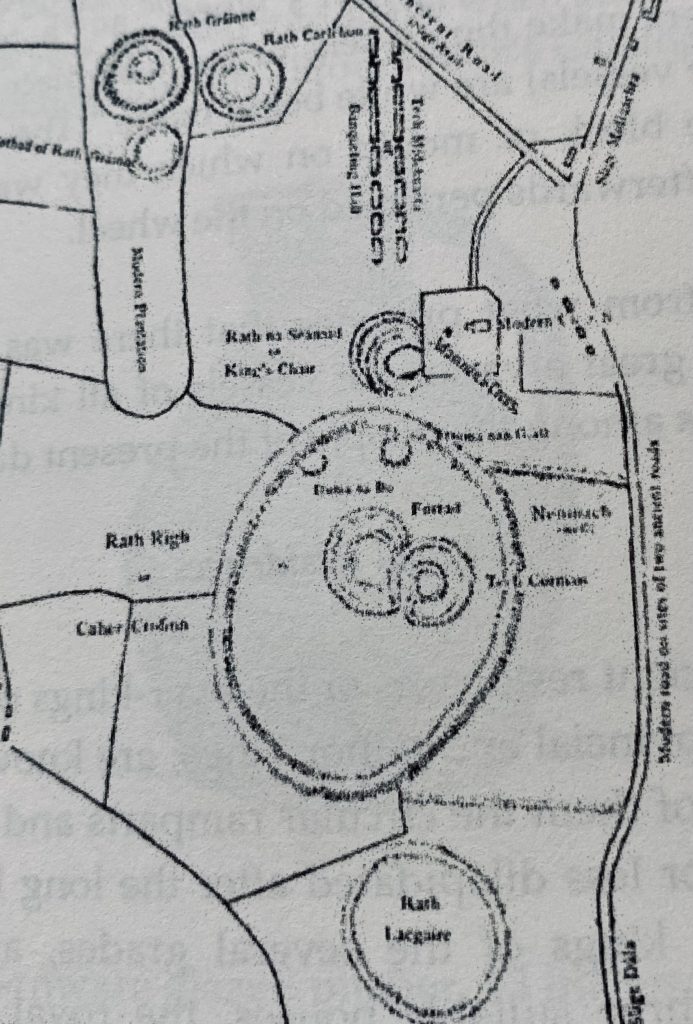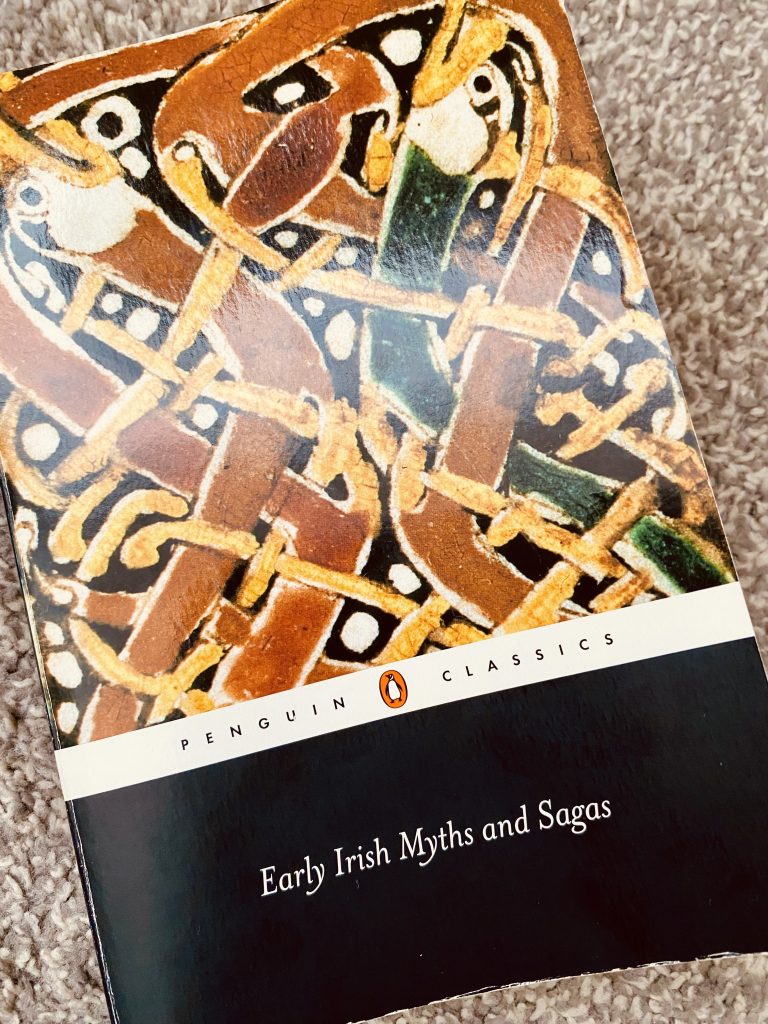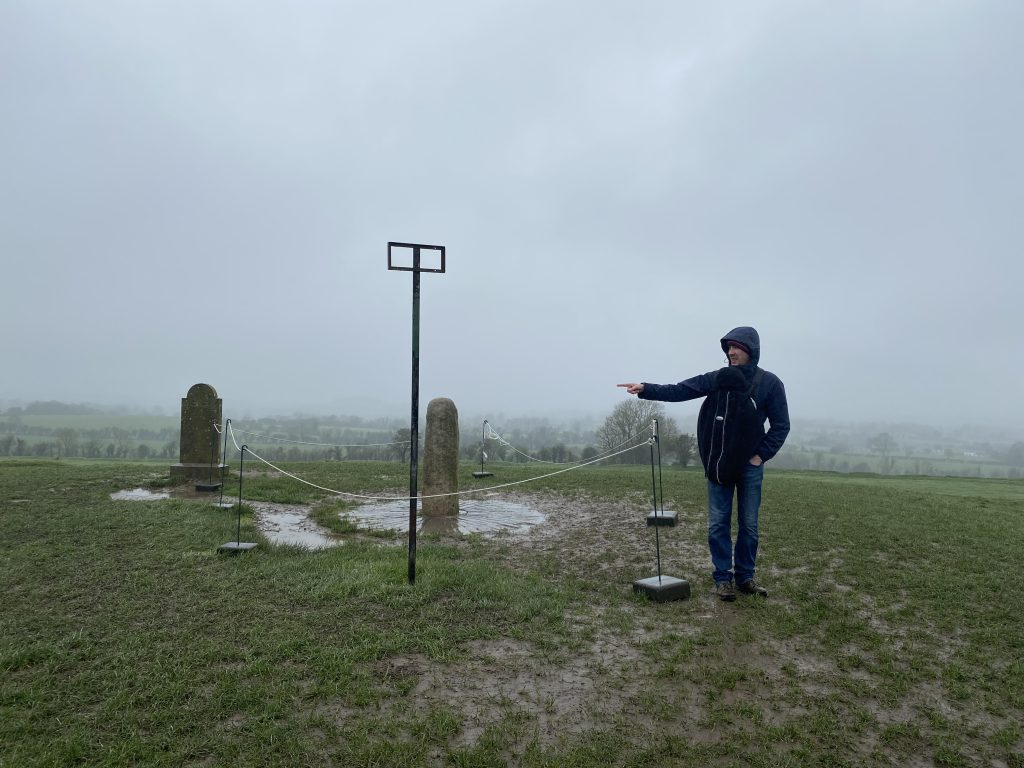Historical landmarks can, in themselves, become symbols and even metaphors for an entire historical period: whether it’s the Coliseum in Rome, the Parthenon in Athens, or the Pyramids in Egypt. These sites take on a character beyond the mere stones and presence they embody, becoming immortalized in the myths, legends, and histories which surround them.
For Ireland, the Hill of Tara should be counted among these. For, while the stones and great buildings of the once great palace and forts have long since disappeared, the site remains central throughout millennia of Irish history.

Let me explain why.
A place of myth
Echu, King of Tara, looks out over the palace’s ramparts, surveying his verdant kingdom like he did every morning. Only this time he sees a lone man walking towards him. This mysterious figure, Midre, hails the king and invites him to a game of fidchell. Rounds of gambling follow with ever increasing stakes, culminating in the King eventually being tricked into betting a kiss and embrace with his wife beautiful wife Étaín’. So goes the Irish myth ‘The Wooing of Étaín’.1
I retell this in brief as it provides a wonderful example of how Tara plays a central role throughout many ancient Irish stories. Others include the ‘Destruction of Da Derga’s Hostel’ or the famous epic ‘Cattle Raid of Cooley’ where Tara appears again and again. It was the site of the High King, the location of a famous festival, a place of judgement, politics and intrigue. And through these colourful tales, these aspects of the site are brought to life.

For instance, the reason the High King Echu was even married to Étaín was because his vassals refused to hold a festival to a king with no queen, which is why Echu then sought out Étaín in the first place. What is truly interesting though is that the High King wanted to hold a festival of Tara “so that their taxes and assessments for the next five years might be reckoned” – the cultural event was entirely political and economic in design. Such snippets of history are woven so beautifully and subtlety into these narratives, it is easy to miss them.
So Tara was and remains central throughout the Irish mythological legacy, and for good reason.
Ireland’s historical backbone
For 5,000-6,000 years Tara has remained a central part of Irish history. The oldest surviving monument on the site is the Mound of the Hostages, “a small passage tomb dating from the third millennium BC.”2 But the catalogue of historical sites is itself staggering.
An 853 ft diameter fortification, called the Fort of the Kings, consisted of “two walls or parapets with a deep ditch between.”3 Within this huge site are two further monuments likely built much later: the bivallate ringfort called Cormac’s House (244 ft-wide) which is linked to the second mound (300 ft-wide) called the Forrad. The Forrad’s name “signifies ‘a place of public meeting’” and a ‘judgement seat,’ cognate with Latin forum”.4
It’s on the Forrad that stands an iconic standing stone 6ft high. Generally, it is regarded as the Lia Fáil, “the inauguration stone of the Irish over-kings”, which legends say roared when presented with a king of true royal heritage.5 However, it is believed to have been moved there in the 19th century from its original place and debate remains over its provenance. Regardless, the presence of such a judicial site shows just how crucial Tara would have once been to the region’s governance.
Cultural landmark
There’s also a 200-m long earthwork avenue which is what remains of the Banqueting Hall. It would have once housed a great timber building which would have reached 45 feet-high, over 750 feet-long and 45 feet-wide with over 12 different doors.6 For a modern reference point, that’s around the height of a contemporary 4-storey dwelling, and over 3,000 sq metres (the average semi-detached house in the UK has 93sqm floor area). The sheer scale of such a building is difficult to exaggerate. You can imagine the feasts and banquets it must have hosted, and the wealth and power to support it.

There are many other significant sites which I don’t have space to cover here, not least over 25 barrows and ring-ditches. But hopefully the point has been well made, that even to use the term ‘Hill of Tara’ is misleading. This is no mere hill. It’s a veritable hotch-podge of historical landmarks all concentrated together; a kaleidoscope of Irish history through the centuries.
An inspiration
Given its mythological roots, it will be no surprise that the ancient site has inspired some of the greatest Irish poets and writers. From the 19th century poet Thomas Moore who wrote his poem ‘The Harp That Once Through Tara’s Halls’,7 to W.B. Yeats’ who wrote his poem ‘In Tara’s Hall’ portraying an aging king wishing to die.8 A television documentary in 2008 notably explained: “For over 5000 years this hill in Meath has been fought over, sung of and died for.”9
The Nobel prize winning poet, Seamus Heaney, sums it up well when he describes Tara as “a source and a guarantee of something old in the country and something that gives the country its distinctive spirit”. The understandable public furor and outrage at the Irish Government’s proposed motorway near the site show just how powerful it remains as a symbol of culture and identity.
And yet, if you are like me and make a visit to this inspirational site of historical and mythological significance, I suspect you will be surprised by what you discover.
Tara today
The rain pounded against our little car as we drove up the narrow, winding roads to Tara. But poor weather couldn’t deter me, nor the bleak visibility. I was too excited. After months of reading and visualising what I’d find, I was never going to turn back.

But after I arrived and drudged up the path to the entrance, it became clear very quickly that reality would fall far short of my expectation.
Having studied the information panels, I soon found myself lost trying to navigate the large site. To the general visitor, I confess it appeared unremarkable – mere mounds and ditches. Signage was poor. Paths non-existent. All of the sites and markers I’ve described are there, but with little to note their presence. Dog-walkers mingle with confused visitors.
As I left deflated, I couldn’t help but wonder why such a central site of national importance had been so neglected.
Tara’s future
Any one of the above features – history, culture, or mythology – would alone justify far better care for this site. I don’t know all the background to why this is not the case, only that surely more could be done. The brilliant examples of other sites like Fort Navan or Newgrange, show what is possible.
As someone who loves Irish history, I was surprised about how deeply this visit impacted me. To be so excited and then disappointed in such a powerful way is painful, an experience I’m sure I’m not alone in enduring.
Thankfully time heals most wounds, even those to our identity. I’ve embraced the Tara of history, of these wonderful stories and poems, and I hope that one-day my passion will be shared by those who get to visit this site too.
For more of my posts please see here or to follow me on Twitter see here
- Gantz, Jeffrey. Early Irish Myths and Sagas. London: Penguin Books, 1981. Pages 52-59 ↩︎
- Rountree, Kathryn, Tara, the M3 and the Celtic Tiger: Contesting Cultural Heritage, Identity, and a
Sacred Landscape in Ireland, Journal of Anthropological Research , WINTER 2012, Vol. 68, No. 4, p523) ↩︎ - Joyce, P.W. A smaller social history of ancient Ireland. Dodo Press, 1901. p243 ↩︎
- Joyce, p243 ↩︎
- Joyce, p244 ↩︎
- Joyce, p245 ↩︎
- For the full poem see: https://allpoetry.com/The-Harp-That-Once-Through-Tara’s-Halls ↩︎
- Yeats, W.B., The Collected Poems of W.B. Yeats. Wordsworth Poetry Library: Herefordshire, 2008. Page 281. ↩︎
- Quoted in Kathryn, p523. ↩︎

Leave a Reply
You must be logged in to post a comment.